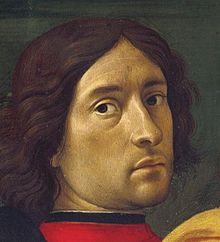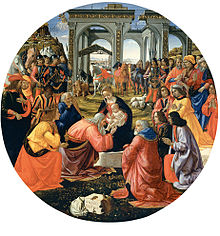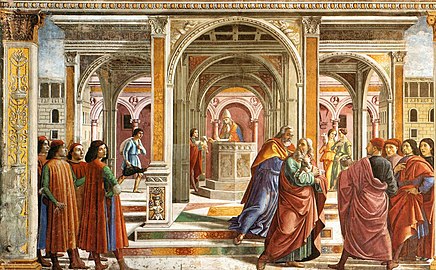Domenico Ghirlandaio
Domenico Ghirlandaio (born June 2, 1448 in Florence ; † January 11, 1494 ibid), actually Domenico di Tommaso Curradi di Doffo Bigordi , was a Florentine painter of the Renaissance .
Life
As the first of eight children born in Florence, Domenico Ghirlandaio took initially trained as a goldsmith on before in the workshop of Alesso Baldovinetti painting and mosaics learned place. While little is known of his early years, it is known that from 1480 until his death at the age of 44, he was a very productive, highly skilled, and widely recognized artist. He was married twice and had three sons and three daughters. Domenico Ghirlandaio's son Ridolfo was also a painter.
Ghirlandaio's successfully established workshop employed numerous employees, including family members such as his three years younger brother Davide Ghirlandaio and Sebastiano Mainardi , who was to marry Domenico Ghirlandaio's sister Alessandra in 1494. One of the most famous students of Ghirlandaio is Michelangelo , who joined the workshop for a short time in 1487 at the age of 13 and whose contribution to Ghirlandaio's works is still lively discussed.
The only surviving signature of the artist in the fresco The Birth of Mary in the Tornabuoni Chapel (“BIGHORDI” and “GRILLANDAI” in the wooden wall paneling) shows that the painter identified himself with both the family name Bigordi and the nickname Ghirlandaio.
Ghirlandaio lived and worked mainly in Florence. He traveled to Rome twice : During the first trip in 1475/1476, he designed a ceiling lunette in the Vatican Apostolic Library with an Aristotle and a Diogenes figure. He went on his second trip in 1481/1482 together with Pietro Perugino , Luca Signorelli , Sandro Botticelli and Cosimo Rosselli to decorate the walls in the Sistine Chapel.
Ghirlandaio died of the plague in 1494.
plant
Ghirlandaio's oeuvre encompasses both sacred and profane pictorial themes. He created panel paintings, monumental frescoes and mosaics. The worldly life of the Renaissance is reflected in his religious representations, which he mostly painted in contemporary surroundings. In his frescoes in the churches of Santa Maria Novella ( scenes from the life of Mary and scenes from the life of John the Baptist in the Tornabuoni Chapel, 1485–1490) and Santa Trinita ( life of St. Francis in the Sassetti Chapel, 1485 ) numerous personalities of his time appear, including several members of the Medici family. Sacred narratives with inserted contemporary portraits are also part of the equipment program for the Vespucci chapel in the Florentine church Ognissanti (around 1474), the chapel in honor of St. Fina in the Collegiate Church in San Gimignano (around 1477) and the Sistine Chapel in the Vatican (1481 ).
The large-scale sacred panel paintings, too, sometimes show inserted contemporaries, such as the altarpiece for the Sassetti family in S. Trinita with the Adoration of the Shepherds (still in the original place in the chapel today), the Adoration of the Kings for the Florentine Ospedale degli Innocenti (1488) and the Tondo with the Adoration of the Magi (before 1487) for Lorenzo Tornabuoni , now in the Uffizi .
Ghirlandaio also painted numerous portraits in which he showed the individuality of his models ( old man with grandson , around 1490, wood, 62 × 46 cm). The old man probably depicts a Florentine patrician - so individual and at the same time so unflattering that doctors were able to diagnose the skin disease on the old man's nose as rose acne ( rhinophyma ).
His two frescoes The Last Supper in the Florentine churches Ognissanti and San Marco are considered to be the immediate forerunners of the painting of the same name by Leonardo da Vinci in Milan .
In the Gemäldegalerie in Berlin , the 44.5 x 31.3 cm image Ghirlandaio is Judith on the way to Bethulien from the year 1489th
The portrait of Giovanna degli Albizzi Tornabuoni is one of the most beautiful portraits of the Florentine Quattrocento . Giovanna's portrait is mostly posthumously dated to around 1489–1490. It is now kept in Madrid's Museo Thyssen-Bornemisza in the Palacio Villahermosa.
Ghirlandaio received most of the orders from wealthy Florentine merchants such as the Sassetti and the Tornabuoni. Some churches were also among his clients. Only one contract has been handed down for the Florentine city government: the Uomini-Famosi fresco cycle in the Palazzo Vecchio (1482–1484).
At the end of his career in 1493 he received a request from Pandolfo Malatesta , ruler of Rimini . He commissioned Ghirlandaio with the creation of an altar panel with three saints and four family members kneeling down for the family chapel in San Cataldo (later the Church of San Domenico), today preserved in the Museo della Città Rimini.
reception
Numerous, prestigious orders in his hometown testify to the high level of appreciation for the Ghirlandaio workshop. Two written testimonies provide information about the contemporary opinion on Ghirlandaio's artistic abilities: Ghirlandaio is praised in a chronicle written by Giovanni Santi , Raphael's father , in honor of the deeds of the late Urbine Duke Federico da Montefeltro in 1482. Ghirlandaio also receives praise in a letter of recommendation from an agent of the Duke of Milan about the most capable painters in Florence from 1490. In addition to Perugino, Sandro Botticelli and Filippino Lippi , Ghirlandaio is also mentioned. This is a master in panel painting and an even greater master in wall painting. His works have a “bona aria” and he would be able to handle many orders - “assai lavoro”.
The biographers of the 16th and 17th centuries gave Ghirlandaio an outstanding importance for his age. In the first place the descriptions of Giorgio Vasari in the Viten Editions of 1550 and 1568 should be mentioned. In it, Vasari particularly admired Ghirlandaio's exact imitation of nature.
Like numerous painters of the Florentine Quattrocento, it was initially forgotten in the 18th century, while the 19th century celebrated it again to the greatest extent. Even Jacob Burckhardt saw in Ghirlandaio one of the outstanding representatives of his generation, just as Ernst Steinmann in a first monograph on the painter from the year 1897th
Parallel to the great recognition, however, an attitude towards the artist emerged early on, which viewed him as a skilled artist but largely uncreative chronicler of his time. Vasari's words were already appreciative, but reserved compared to his other artist descriptions. Above all, organizational aspects and the skill of the artist are mentioned with praise - there was no excessive praise, as was the case with the “geniuses” of the High Renaissance such as Michelangelo.
In the art criticism of the 20th century, this opinion about the artistic abilities of Ghirlandaio was consolidated, which denied him the genius in the idea. Aby Warburg judged that, in contrast to Michelangelo, Ghirlandaio “as the owner of a hard working workshop has the ambition to reflect faithfully, not to redesign it in a spirited way.” For a long time he was considered an “illustrator” of the society of des in research in the 20th century 15th century - so the Tornabuoni frescoes "show us the everyday Florentine life in an unsurpassable way." Even if Ghirlandaio's contemporary popularity was not doubted, the result of his efforts classifies him more as a "portrait supplier" than " Artisans ”, says Warburg. Compared with the timelessness of the art of other Florentine painters of the Quattro and Cinquecento, which is attested today, Ghirlandaio was long considered an artist who was arrested in his time.
The most recent research attempts to revise this judgmental judgment of Ghirlandaio's abilities that research of the previous century had made so freely. Jean Cadogan embarked on new ways of assessing artists early on, and in her studies she showed that the inclusion of role models at Ghirlandaio was complex and specific. The 500th anniversary of the painter's death in 1994 created impetus for renewed intensive scientific work. The two comprehensive academic monographs from 2000 by Jean Cadogan and Ronald Kecks pave the way for a reassessment of Ghirlandaio's oeuvre.
Illustrations
(Selection)
Jerome studying (in the Ognissanti Church, Florence, 1480)
- Frescoes by Domenico Ghirlandaio in the Tornabuoni Chapel of the Santa Maria Novella Church in Florence
literature
- Marco Chiarini: BIGORDI, Domenico, detto (del) Ghirlandaio. In: Alberto M. Ghisalberti (Ed.): Dizionario Biografico degli Italiani (DBI). Volume 10: Biagio-Boccaccio. Istituto della Enciclopedia Italiana, Rome 1968.
- Jan Lauts: Ghirlandaio, Verlag Anton Schroll, Vienna 1943.
- Wolfram Prinz / Max Seidel (eds.): Domenico Ghirlandaio 1449–1494. Atti del Convegno Internazionale Firenze, 16-18 October 1994. Centro Di, Florence 1996, ISBN 978-88-7038-276-1 .
- Andreas Quermann: Domenico Ghirlandaio. Könemann Verlag, Cologne 1998, ISBN 3-8290-0690-X (in the Masters of Italian Art series ).
- Ronald G. Kecks: Domenico Ghirlandaio and the painting of the Florentine Renaissance. Deutscher Kunstverlag, Munich 2000, ISBN 3-422-06282-3 (Italian research by the Art History Institute in Florence, fourth volume, volume II).
- Jean K. Cadogan: Domenico Ghirlandaio. Artist and Artisan. Yale University Press, New Haven, et al. 2000, ISBN 978-0-300-08720-8 .
- Michael Rohlmann: Ghirlandaios Florence. In: Michael Rohlmann (Ed.): Artistic construction of identity in the Florence of the Renaissance. VDG Weimar, Weimar 2003, ISBN 978-3-89739-371-4 , pp. 9-61.
- Michael Rohlmann: The intertwining of family fate and salvation history in Ghirlandaios Sassetti Chapel. In: Michael Rohlmann (Ed.): Artistic construction of identity in the Florence of the Renaissance. VDG Weimar, Weimar 2003, ISBN 978-3-89739-371-4 , pp. 165–243.
- Andreas Quermann: Domenico Ghirlandaio. In: Eberhand König (ed.): The great painters of the Italian Renaissance. Volume 1: The Triumph of Drawing. Ullmann Publishing, Königswinter 2007, ISBN 978-3-8331-2564-5 , pp. 426-439, pp. 512-539.
- Giorgio Vasari : The life of Domenico Ghirlandaio and Gherardo di Giovanni. Newly translated into German by Victoria Lorini. Ed., Commented by, introduced by Annette Hojer. Verlag Klaus Wagenbach , Berlin 2014, ISBN 978-3-8031-5061-5 .
- Maria Merseburger: Painted drapery in the Florentine Quattrocento. Ghirlandaios Tornabuoni Chapel. Humboldt-Univ., Diss., Berlin 2018 online .
Web links
- Works by Domenico Ghirlandaio at Zeno.org .
- Web Gallery of Art
- Publications on Domenico Ghirlandaio in the Opac of the Regesta Imperii
Individual evidence
- ↑ For a discussion of the divorce of hands in the Tornabuoni Chapel, cf. Ronald G. Kecks: Domenico Ghirlandaio and the painting of the Florentine Renaissance. Deutscher Kunstverlag, Munich 2000, ISBN 978-3-422-06282-5 , pp. 281f.
- ↑ On Ghirlandaios death by the plague cf. the death register ("Registro de 'fratelli morti") of the Compagnia di San Paolo: "Domenicho di Tommaso di Churrado Bighordi, dipintore, detto del Ghirlandaio, morì sabato mattina a dì XI di gennaio 1493 (1494, today's calendar) di febre pestilenziale" , quoted n. Giorgio Vasari : Le vite de 'più eccellenti pittori, scultori ed architettori. 2nd edition, Florence 1568, ed. v. Gaetano Milanesi , 8 vol. And reg., Florence 1878–1885, vol. 3, p. 277, note 2.
- ↑ In preparation for the Sassetti frescoes cf. Aby Warburg: Portrait art and Florentine bourgeoisie, I: Domenico Ghirlandaio in S. Trinita. The portraits of Lorenzo de 'Medici and his relatives. In: Aby Warburg: Collected writings. 2 vol., Leipzig 1932, vol. 1, pp. 89-126; Aby Warburg: Francesco Sassetti's last will. In: Aby Warburg: Collected writings. 2 vol., Leipzig 1932, vol. 1, pp. 127–158. After Warburg, Eve Borsook and Johannes Offerhaus made particular efforts to interpret the fresco program in the Sassetti Chapel, cf. Eve Borsook / Johannes Offerhaus: Francesco Sassetti and Ghirlandaio at Santa Trinita, Florence: History and Legend in a Renaissance Chapel. Doornspijk 1981; Eve Borsook / Johannes Offerhaus: Story e leggende nella cappella Sassetti in Santa Trinita. In: Maria e Paolo dal Poggetto (ed.): Scritti di storia dell'arte in onore di Ugo Procacci. 2 vol., Electa, Milan 1977, vol. 1, pp. 289-310; also Michael Rohlmann: The intertwining of family fate and salvation history in Ghirlandaios Sassetti Chapel. In: Michael Rohlmann (Ed.): Artistic Construction of Identity in the Florence of the Renaissance VDG Weimar, Weimar 2003, ISBN 978-3-89739-371-4 , pp. 165–243.
- ↑ On the Vespucci Chapel, cf. Karl Schlebusch: New documents on the Vespucci Chapel in Ognissanti and on the Domenico Ghirlandaio family. In: Mitteilungen des Kunsthistorisches Institut in Florenz 53 (2009), pp. 364– 374
- ↑ The Santa Fina Chapel has so far received little scientific attention; an exception is the essay by Linda A. Koch: The Portrayal of Female Sainthood in Renaissance San Gimignano: Ghirlandaio's Frescoes of Santa Fina's Legend. In: Artibus et Historiae 19, H. 38 (1998), pp. 143-170
- ↑ Warning, nymph in the basement. In: FAZ . February 6, 2013, p. 29.
- ↑ Going further in particular Gert Jan van der Sman (Ed.): Ghirlandaio y el Renacimiento en Florencia. Exhibition catalog. Museo Thyssen-Bornemisza Madrid, Madrid 2010, ISBN 978-84-96233-89-8 , pp. 276-279; Maria K. DePrano: "No painting on earth would be more beautiful": An Analysis of Giovanna degli Albizzi's Portrait Inscription. In: Renaissance Studies 22, H. 5 (2008), pp. 617–641
- ^ Federigo di Montefeltro duca di Urbino: Cronaca di Giovanni Santi. After d. Cod. Vat. Ottob. 1305, first ed. v. H. Holtzinger, Stuttgart 1893. Made accessible to a wider audience in 1924 by Julius von Schlosser : Die Kunstliteratur. A handbook for source studies in modern art history. Unchanged reprint of the issue of 1924, Vienna 1985, pp. 97-99.
- ↑ "Dominico de Grilandaio bono maestro in tavola et piu in muro: le cose sue hano bona aria, et e homo expeditivo, et che conduce assai lavoro." In: Archivio di Stato di Milano, Sezione storia, Autografi, Pittori: Sec. XV e varietà, single sheet, first publ. in: Paul Müller-Walde: Contributions to the knowledge of Leonardo da Vinci. In: Yearbook of the Royal Prussian Art Collections 18 (1897), pp. 92–169, p. 165.
- ↑ Vasari's vitae versions (1550, 1568) hardly differ from one another in Ghirlandaio's case. The most recent translation in: Giorgio Vasari: The life of Domenico Ghirlandaio and Gherardo di Giovanni. Newly translated into German by Victoria Lorini. Ed., Commented by, introduced by Annette Hojer. Verlag Klaus Wagenbach, Berlin 2014, ISBN 978-3-8031-5061-5 .
- ^ Jacob Burckhardt: The Cicerone. A guide to enjoying Italian works of art. Basel 1855, new printer of the original edition, Stuttgart 1986, p. 762; Ernst Steinmann: Ghirlandaio. Bielefeld / Leipzig 1897, Velhagen & Klafing, p. 3.
- ↑ For example Heinrich Wölfflin : The classical art. An Introduction to the Italian Renaissance. F. Bruckmann, Munich 1914 (1st edition 1899), p. 18f.
- ^ Aby Warburg: Florentine Reality and Antiqueizing Idealism. In: Martin Treml / Sigrid Weigel / Perdita Ladwig (eds.): Aby Warburg. Works in one volume. Suhrkamp, Berlin 2010, ISBN 978-3-518-58531-3 , pp. 211-233, p. 228.
- ^ André Chastel: Die Kunst Italiens, 2 vol., Emil Vollmer Verlag, Munich 1978, ISBN 3-87876-304-2 , vol. 1, p. 331f.
- ^ Antonio Paolucci (ed.): Churches in Florence. Hirmer, Munich 2003, ISBN 978-3-7774-9960-4 , p. 172
- ^ Aby Warburg: Florentine Reality and Antiqueizing Idealism. In: Martin Treml / Sigrid Weigel / Perdita Ladwig (eds.): Aby Warburg. Works in one volume. Suhrkamp, Berlin 2010, ISBN 978-3-518-58531-3 , pp. 211-233, p. 228.
- ↑ When comparing the preliminary drawing and the executed fresco, Cadogan convincingly proves that Ghirlandaio did not copy but interpreted, cf. Jean K. Cadogan: Observations on Ghirlandaio's Method of Composition. In: Master Drawings 22, H. 2 (1984), pp. 159–172, pp. 223–235, p. 169 and Jean K. Cadogan: Reconsidering Some Aspects of Ghirlandaio's Drawing. In: The Art Bulletin 65 (1983), pp. 274-290.
- ↑ The Galleries of Europe, paintings by old masters in the colors of the originals . EASeemann Verlag, Leipzig 1909, OCLC 256857019 .
| personal data | |
|---|---|
| SURNAME | Ghirlandaio, Domenico |
| ALTERNATIVE NAMES | Bigordi, Domenico di Tommaso Curradi di Doffo (real name) |
| BRIEF DESCRIPTION | Florentine Renaissance painter |
| DATE OF BIRTH | June 2, 1448 |
| PLACE OF BIRTH | Florence , Italy |
| DATE OF DEATH | January 11, 1494 |
| Place of death | Florence , Italy |
















